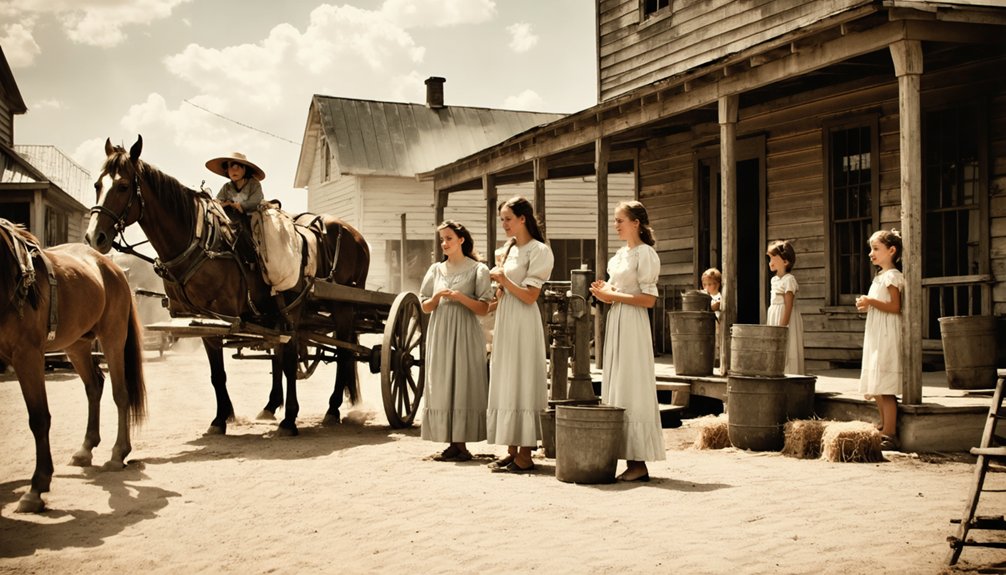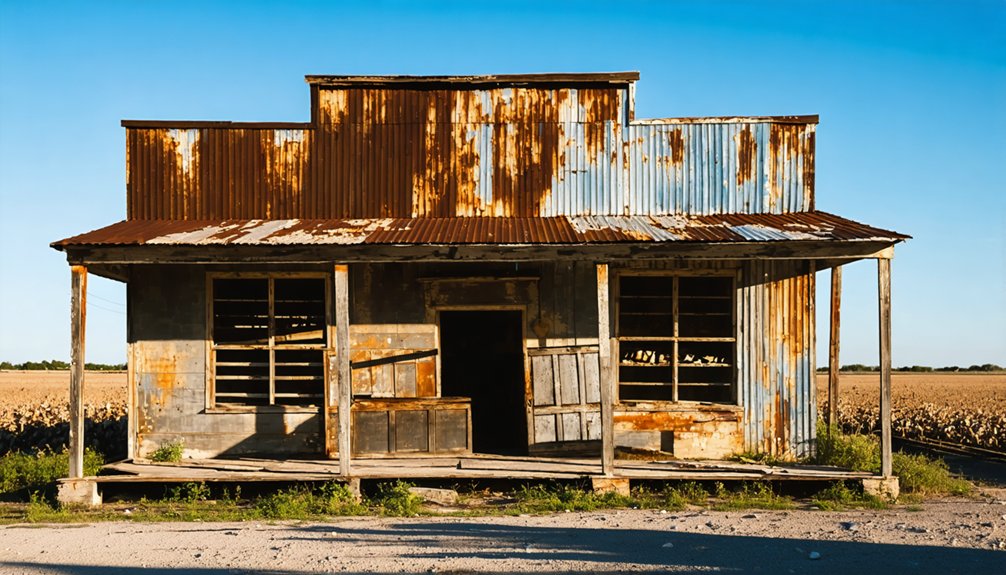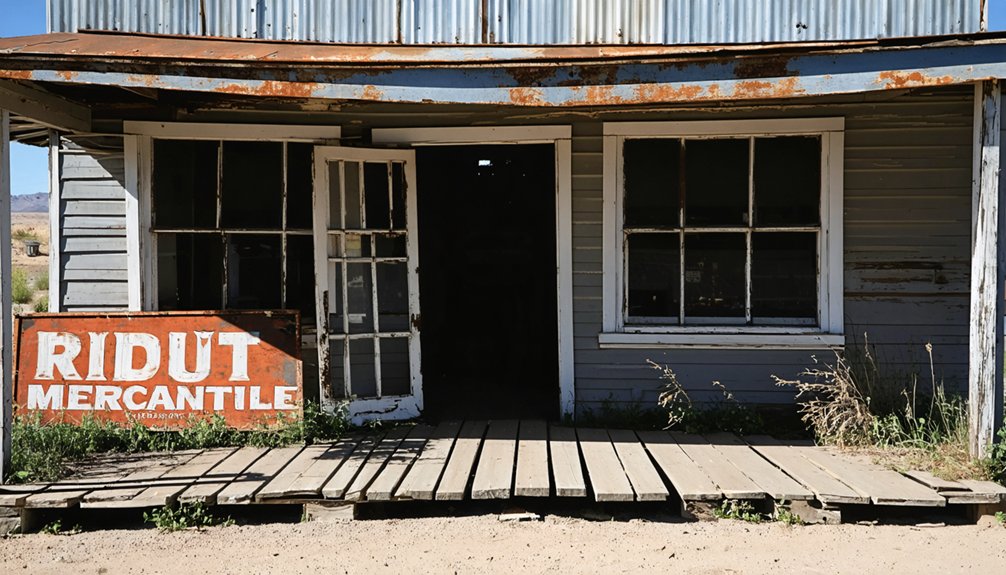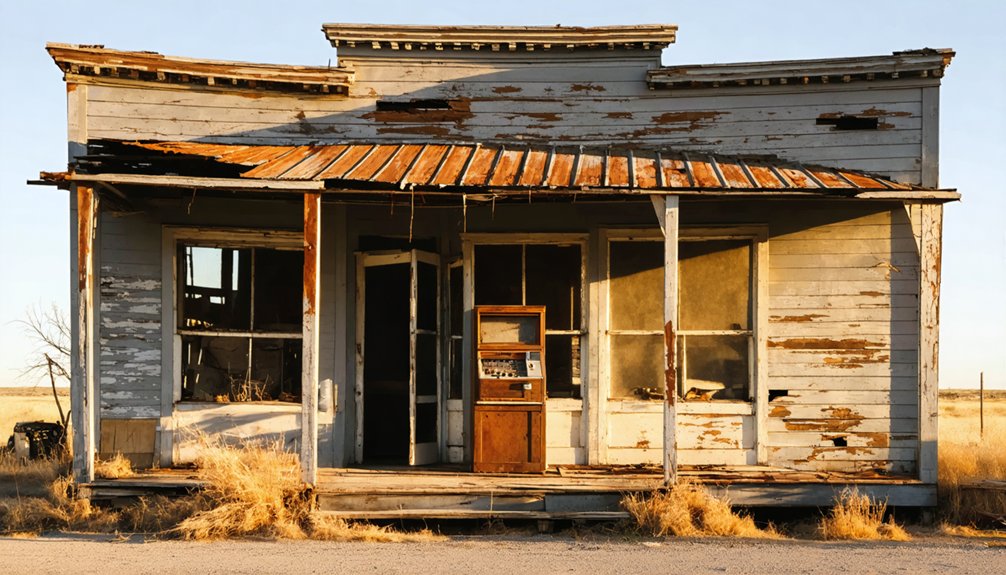You’ll find Ridout, a ghost town in Wilson County’s blackland prairie region, about 15 miles southeast of San Antonio. This former agricultural settlement thrived in the early 1900s with a post office, one-room schoolhouse, church, and general store serving local farmers. The town’s fortunes declined during the 1930s Dust Bowl, and the abandonment of the Chicago, Rock Island and Gulf Railway sealed its fate. Today, scattered foundations and ruins tell stories of Texas’s boom-and-bust frontier past.
Key Takeaways
- Ridout is one of Wilson County’s 31 ghost towns, located in south-central Texas about 15 miles southeast of San Antonio.
- The town flourished as an agricultural settlement with a post office, schoolhouse, church, and general store before its decline.
- Economic decline began during the 1930s Dust Bowl, with the abandonment of railway services further isolating the community.
- Visitors can explore building foundations, remnants of the post office, and traces of the old Chicago, Rock Island and Gulf Railway.
- Access requires private transportation, and visitors should prepare for remote conditions with limited cell service and amenities.
The Rise and Fall of a Wilson County Settlement
While many Texas ghost towns boomed and busted with oil discoveries, Ridout followed a quieter trajectory as an agricultural settlement in Wilson County during the late 19th or early 20th century.
You’ll find its settlement patterns matched those of numerous small farming communities that once dotted the region, serving local rural residents and farms with modest commerce.
Like other Wilson County towns, Ridout’s destiny hinged on transportation routes and agricultural prosperity.
Like so many rural settlements, Ridout’s fate was tied to the twin threads of farming success and accessible travel routes.
When railroads bypassed the area and farming faced hardships during the 1930s Dust Bowl, the town’s energy began to slip away. Similar to the fate of Helena, where the railroad rerouting caused its decline, Ridout’s isolation from major transportation routes sealed its destiny.
This agricultural decline, combined with the lack of modern amenities and shifting transportation patterns, led to steady population loss. Young residents continue to depart from rural communities like Ridout, further contributing to its ghost town status.
Today, Ridout stands among Wilson County’s 31 ghost towns, evidence of the changing fortunes of rural Texas.
Geographic Location and Landscape
You’ll find Wilson County’s rural landscape marked by gently rolling blackland prairie and post oak savannah, where Ridout once existed among scattered agricultural settlements.
The region’s natural features include fertile soil that historically supported cotton and corn farming, along with native grasses, live oaks, and seasonal wildflowers characteristic of Texas’s Coastal Plains. Today, the area offers Farm-to-Market Roads providing access to explore the surrounding countryside. Like the overgrown abandoned areas of Leadbetter, nature has reclaimed much of the former settlement’s footprint.
While Ridout’s exact coordinates remain unknown, its location within Wilson County placed it among the network of small communities that emerged between the borders of Bexar, Guadalupe, Gonzales, Karnes, and Atascosa counties.
Wilson County Rural Setting
Located in south-central Texas, Wilson County sprawls across 808 square miles of the upper coastal plain region, positioned just 15 miles southeast of San Antonio.
You’ll find a landscape dominated by flat to gently rolling hills, with elevations between 290 and 804 feet above sea level. Deep loamy soils with clayey subsoils create ideal conditions for the county’s strong agricultural heritage, particularly evident in its thriving peanut industry producing over 30 million pounds annually.
The rural economy thrives on diverse farming and ranching operations, supported by natural features like the San Antonio River to the west and Cibolo Creek to the east. The area maintains its less congested atmosphere, offering residents a peaceful rural lifestyle away from urban development. The region’s rich history dates back to early settler farms that established the foundation for today’s agricultural success.
Native grasses, mesquite, live oak, and seasonal wildflowers blanket the countryside, while wildlife like white-tailed deer and turkey roam freely across the pastoral setting.
Local Terrain Features
The rugged terrain surrounding Ridout’s ghost town site mirrors much of Texas’s diverse geographic character.
You’ll find the terrain composition varies considerably, with a mix of plains and subtle elevation changes typical of this region. The landscape’s natural contours have been shaped by years of weather patterns and geological processes that define much of the state’s rural areas.
When you explore the area, you’ll notice the vegetation types change with the seasonal patterns. Native grasses and scattered trees dot the landscape, adapting to the local climate conditions. The area’s vegetation includes local water-fed trees that thrive near hidden springs and water sources. Much like the conditions that challenged Katarina’s settlers, water availability has always been a crucial factor in shaping the local environment.
The natural water sources that once supported the settlement have left their mark on the land, creating subtle variations in the soil composition and plant life. These features tell the story of how early settlers chose this location for their community.
Regional Settlement Patterns
As part of Texas’s rural landscape, Ridout’s settlement patterns reflect common geographic choices made by frontier communities during the state’s westward expansion.
Like many Texas ghost towns, you’ll find that the region’s settlement patterns followed predictable demographic shifts tied to resource availability and transportation routes. Similar to Independence, the town’s fate was likely influenced by decisions regarding railroad access routes. The area’s development mirrored other mining communities with barbed wire fencing encircling the settlement to control access.
- The town’s layout likely followed typical grid patterns seen in planned frontier settlements, maximizing accessibility and organization.
- Settlement growth would have matched the expansion of resource extraction or agricultural development in the surrounding area.
- The community’s placement probably capitalized on natural features that supported economic activities and trade routes.
- Initial population distribution would have centered around key infrastructure, such as railroad stops or resource processing facilities, with residential areas developing outward from these focal points.
Historical Timeline and Key Events
While specific historical records for Ridout remain elusive, typical settlement patterns of Texas ghost towns suggest the community likely emerged during a period of westward expansion and economic development in the state.
The historical significance of such settlements often parallels the broader Texas narrative of boom-and-bust cycles tied to natural resources or transportation routes.
Like many ghost towns, Ridout’s timeline probably included an initial period of growth with basic infrastructure development, followed by economic challenges that led to its decline.
Ridout’s story echoes a familiar pattern: hopeful beginnings, infrastructure growth, then gradual decline as economic realities shifted.
Community memories of these settlements typically recall the establishment of churches, schools, and local businesses, followed by gradual depopulation as economic conditions changed.
Whether due to shifting transportation routes, resource depletion, or changing market conditions, Ridout eventually joined the ranks of Texas’s forgotten communities.
Daily Life in Early Ridout

Daily routines in early Ridout reflected common patterns of Texas frontier life, where agricultural pursuits dominated weekday activities.
You’d find families gathering at the local church for Sunday services, followed by potluck meals featuring local cuisine like Texas barbecue and home-cooked dishes.
During weekdays, residents split their time between tending to crops, managing livestock, and operating small businesses that served the community’s basic needs.
- Dawn-to-dusk farm work shaped most families’ daily schedules
- Evening gatherings often centered around front porches and communal spaces
- Seasonal celebrations brought the community together for harvest festivals and holiday events
- Outdoor activities like hunting and fishing supplemented both food supplies and recreation
The simple lifestyle fostered strong community bonds, with neighbors helping neighbors through shared work and social activities.
Notable Buildings and Structures
Weathered foundations and skeletal structures dot the Ridout landscape today, offering glimpses into the town’s architectural heritage.
You’ll find the original post office building still standing as the most intact reminder of Ridout’s historic significance. The one-room schoolhouse ruins and church foundations showcase typical rural Texas architectural styles, while the partially standing general store frame marks what was once the town’s commercial heart.
Throughout the settlement, you’ll discover scattered residential foundations featuring cellar depressions and chimney remains, revealing how early settlers adapted local materials for their homes.
The ruins of agricultural mills, barn foundations, and workshop remains tell the story of a self-sufficient community. While nature slowly reclaims these structures, they continue to provide valuable insights into Ridout’s pioneering past.
The Community’s Economic Base

The economic foundation of Ridout rested primarily on agricultural production and railroad commerce during its peak years from 1885 to 1920.
As many Texas towns of that era, Ridout’s prosperity depended heavily on its ability to serve as a transportation hub for local farmers and merchants.
When the town faced economic challenges in the early 20th century, limited economic diversification options and declining community engagement made it difficult to adapt to changing market conditions.
- Rail transportation played an essential role in connecting Ridout’s agricultural products to broader markets
- Local farming operations provided the bulk of employment and economic activity
- The town’s merchants relied heavily on trade from surrounding agricultural communities
- Attempts to establish secondary industries failed due to limited infrastructure and resources
Transportation Routes and Access
You’ll find that Ridout’s early growth depended heavily on the Chicago, Rock Island and Gulf Railway, which brought cattle shipments and economic activity to the area by 1906.
Today, you must navigate secondary roads and detours since major highways no longer pass directly through the former townsite.
While exploring the remnants of Ridout, you can follow informal walking paths that trace the old railroad grade and connect various historic building sites.
Historic Railroad Access Points
Railroad access points in Ridout emerged during Texas’s rapid rail expansion of the late 1800s, connecting the town to major regional markets and trade routes. The railroad importance for Ridout mirrored the state’s broader transportation challenges, as communities fought to secure essential rail connections that would determine their economic fate.
- Historic depots served as Ridout’s primary gateway for goods, agriculture, and passenger services.
- Rail access points created a network linking Ridout to established markets in Palestine and Rusk.
- Strategic placement along rail routes initially fueled the town’s growth and development.
- When rail lines were abandoned, Ridout lost its competitive advantage as a transportation hub.
You’ll find that Ridout’s story reflects the rise and fall of many Texas towns whose fortunes were tied to their railroad connections.
Modern Road Networks
While Ridout’s railroad era has long passed, modern road networks now provide primary access to this historic ghost town site. You’ll find Texas State Highway 144 and U.S. Highway 67 serving as the major arteries near Ridout, with Farm to Market roads like FM 203 connecting to the immediate vicinity.
Recent road improvements in Somervell County have enhanced routes to Glen Rose, just 12 miles away, though accessibility challenges remain closer to the ghost town itself.
You’ll need to navigate unpaved sections and weather-dependent dirt roads to reach Ridout’s remains. There’s no formal parking infrastructure at the site, but you can find primitive pull-off areas along nearby Farm to Market roads.
Remember that access restrictions apply on private lands, and you’ll need your own vehicle as public transit doesn’t serve the area.
Walking Trail Possibilities
Situated within Ridout’s historic townsite, several walking trail possibilities offer visitors unique perspectives of this former mining community.
You’ll find a network of paths ranging from old mining roads to natural terrain routes that showcase the area’s rich history. Walking trail accessibility varies from well-marked self-guided tours to more challenging wilderness paths that require navigation skills.
- Historical trail experiences along former mining roads reveal remnants of ore chutes, cabins, and vintage equipment.
- Natural walking paths follow creek beds and ridgelines, connecting various ghost town features through scenic woodland areas.
- Self-guided interpretative routes with informational markers help you explore key points of interest safely.
- Off-road trails shared with 4×4 vehicles provide access to remote sites, with designated parking areas at trailheads.
Why Ridout Became a Ghost Town
Like many small Texas settlements that faded into obscurity, Ridout’s decline stemmed from a perfect storm of economic and infrastructural challenges in the early 20th century.
When major railroad lines bypassed the town, you’d have witnessed the beginning of economic isolation as businesses and residents relocated to better-connected areas.
Agricultural decline hit the community hard, with soil exhaustion and water scarcity making farming increasingly difficult.
As essential services shut down – including the post office, schools, and general stores – the town’s remaining population faced tough choices.
Young people left for urban opportunities, while older residents struggled with diminishing resources and community support.
Regional economic downturns, particularly during the Great Depression, delivered the final blows to this once-hopeful Texas settlement.
Exploring Ridout Today

Today’s visitors to Ridout will find a haunting collection of deteriorating structures scattered across the remote Texas landscape.
Ghost town photography enthusiasts and history buffs should prepare for challenging conditions, as access roads are poorly maintained and facilities are nonexistent. Historical preservation efforts by county commissions have established markers, but most structures remain in advanced decay.
Ridout’s crumbling ruins tell their own story, but visitors face rough roads and zero amenities in this remote ghost town.
- You’ll need a private vehicle to reach the site, as public transportation isn’t available
- Pack essential supplies – there are no amenities, cell service is limited, and help is far away
- Watch for structural hazards in and around remaining buildings
- Visit during dry weather when roads are most passable and visibility is best
For the adventurous explorer, Ridout offers an authentic glimpse into Texas’s abandoned past, though safety precautions are essential.
Frequently Asked Questions
Were There Any Documented Murders or Crimes in Ridout’s History?
You won’t find documented murder mysteries or crime history from Ridout’s past – historical records and archives reveal no significant violent crimes, making it distinctly different from other crime-ridden Texas ghost towns.
What Native American Tribes Originally Inhabited the Ridout Area?
Like ancient footprints in shifting sands, you’d find the Caddo tribes were first in this area, with their rich cultural significance marking these lands before Comanche groups later arrived.
Did Any Famous Historical Figures Ever Visit or Stay in Ridout?
You won’t find any documented famous visitors or historical significance for this location, as there’s no verifiable evidence of notable figures ever staying or passing through this particular area.
What Was the Average Property Value in Ridout During Its Peak?
While there’s no exact data, you’d find property market values likely ranged from $200-2,000 during peak times, following historical trends seen in similar Texas ghost towns of the early 1900s.
Were There Any Natural Disasters That Affected the Town of Ridout?
You can’t confirm any flood impacts or drought effects in Ridout, as historical records don’t document any natural disasters affecting the town. The evidence simply doesn’t exist in available sources.
References
- https://www.youtube.com/watch?v=Ux4FjzHs5DE
- https://www.hipcamp.com/journal/camping/texas-ghost-towns/
- https://www.youtube.com/watch?v=phjUE19A8HM
- https://texashillcountry.com/5-haunting-texas-ghost-towns/
- https://texashighways.com/travel-news/four-texas-ghost-towns/
- https://www.ksat.com/holidays/2018/10/30/texas-has-more-ghost-towns-than-any-other-state/
- https://www.tpr.org/texas/2017-10-30/boo-the-rise-and-fall-of-texas-ghost-towns
- https://en.wikipedia.org/wiki/List_of_ghost_towns_in_Texas
- https://texashistory.unt.edu/explore/collections/TGTN/
- https://www.county.org/county-magazine-articles/summer-2025/ghost-towns



